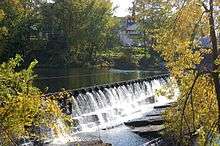Chicopee River
| Chicopee River | |
|---|---|
 Chicopee Falls | |
| Country | US |
| Basin | |
| Main source |
Palmer, Massachusetts 42°10′51″N 72°21′55″W / 42.1807°N 72.3654°W |
| River mouth |
Connecticut River 42°08′54″N 72°37′18″W / 42.1482°N 72.6217°WCoordinates: 42°08′54″N 72°37′18″W / 42.1482°N 72.6217°W |
| Basin size | 721 square miles (1,870 km2) |
| Physical characteristics | |
| Length | 18.0 mi (29.0 km) |
The Chicopee River is an 18.0-mile-long (29.0 km)[1] tributary of the Connecticut River in Metropolitan Springfield, Massachusetts, known for fast-moving water and its extraordinarily large basin: the Connecticut River's largest tributary basin.[2] The Chicopee River originates in a Palmer, Massachusetts village called Three Rivers, and then flows into the Connecticut River after passing through Ludlow, the Indian Orchard neighborhood of Springfield, and then curving sharply northwest before finding its confluence in downtown Chicopee, Massachusetts.
Largest Connecticut River tributary basin
Although the Chicopee River itself is only 18 miles long, its basin (drainage area) is 721 square miles (1,870 km2)—the largest in all of Massachusetts, and the largest tributary area (basin) to the Connecticut River.[2] A basin tributary to the Connecticut River represents a geographical area with a stream or other body of water, surface or underground, that contributes water to the Connecticut River. With so many streams and rivers that deliver water to the Connecticut River, the scale of the Chicopee River's Basin is extraordinarily voluminous.
Indeed, the Chicopee River Watershed includes all or part of 32 cities and towns.[2]
260-foot drop in 18 miles
During the Industrial Revolution, the Chicopee River became a particularly sought-after destination for hydropower, largely because it drops 260 feet during its 18 mile course to the Connecticut River. By comparison, the meandering Connecticut River drops just 50 feet from Chicopee to Old Saybrook, Connecticut, where it empties into the Long Island Sound.[2] For this reason, numerous mills were built along the Chicopee River; today, many of them can be found in various states of repurposing, with a particularly famous mill in Springfield Indian Orchard serving as artists' space.[3]
Due in part to its precipitous drop, as of 2011, there are six hydropower dams on the Chicopee River. The average flow of the Chicopee River is 900 cubic feet per second, or about 581,644,800 gallons per day.[2]
History
Historical texts often state that the Chicopee River flows into the Connecticut River at Springfield, Massachusetts; however, in 1848, the City of Chicopee was carved out of Springfield's northern neighborhoods. Essentially, certain factions that opposed Springfield becoming a chartered city, and adopting the mayoral-style government such a change would entail, hatched the plan to create Chicopee with the idea of slicing off 2/5 of Springfield's population, thereby making it a place with too few people to become a legally chartered city. The plan succeeded and thus, from Springfield, came Chicopee. Ironically however, Springfield became a city only four years later - and Chicopee not long after that, with the split only serving to further fragment a region composed of - by United States standards - municipalities of small land area. Regardless, today the Chicopee River finds its confluence with the Connecticut River 0.5-mile (0.80 km) north of Springfield's northern border, in Chicopee - not Springfield.
References
- ↑ U.S. Geological Survey. National Hydrography Dataset high-resolution flowline data. The National Map Archived 2012-04-05 at WebCite, accessed April 1, 2011
- 1 2 3 4 5 Chicopee River Watershed Council, Chicopee, MA - Frequently Asked Questions. Chicopeeriver.org. Retrieved on 2013-07-15.
- ↑ Indian Orchard Mills. Indian Orchard Mills. Retrieved on 2013-07-15.
External links
- "Chicopee River Watershed", Massachusetts Executive Office of Energy and Environmental Affairs
- River Watershed Council